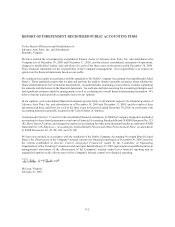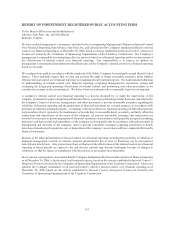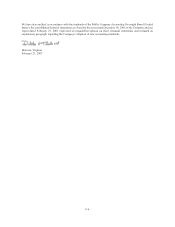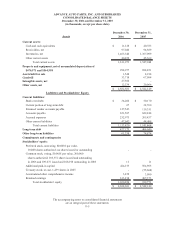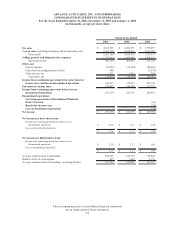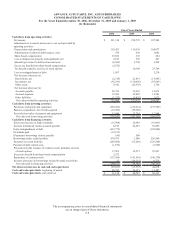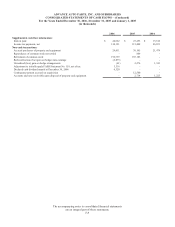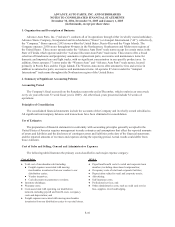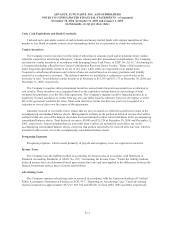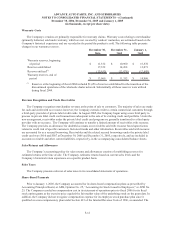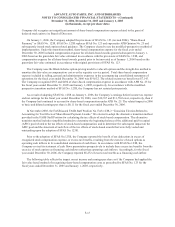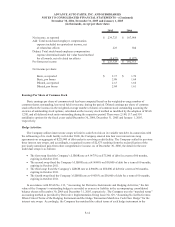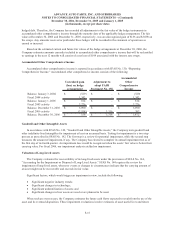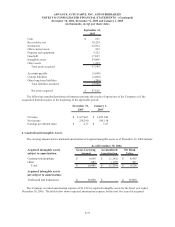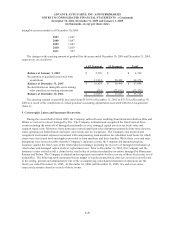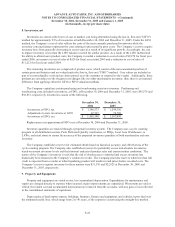Advance Auto Parts 2006 Annual Report Download - page 75
Download and view the complete annual report
Please find page 75 of the 2006 Advance Auto Parts annual report below. You can navigate through the pages in the report by either clicking on the pages listed below, or by using the keyword search tool below to find specific information within the annual report.
ADVANCE AUTO PARTS, INC. AND SUBSIDIARIES
NOTES TO CONSOLIDATED FINANCIAL STATEMENTS – (Continued)
December 30, 2006, December 31, 2005 and January 1, 2005
(in thousands, except per share data)
Warranty Costs
The Company's vendors are primarily responsible for warranty claims. Warranty costs relating to merchandise
(primarily batteries) sold under warranty, which are not covered by vendors' warranties, are estimated based on the
Company's historical experience and are recorded in the period the product is sold. The following table presents
changes in our warranty reserves.
December 30, December 31, January 1,
2006 2005 2005
Warranty reserves, beginning
of period 11,352$ 10,960$ 15,578$
Reserves established 17,352 14,268 13,071
Reserves utilized
(1)
(15,635) (13,876) (17,689)
Warranty reserves, end of
period 13,069$ 11,352$ 10,960$
(1) Reserves at the beginning of fiscal 2004 included $1,656 of reserves established for the transition of the
discontinued operations of the wholesale dealer network. Substantially all these reserves were utilized
during fiscal 2004.
Revenue Recognition and Trade Receivables
The Company recognizes merchandise revenue at the point of sale to customers. The majority of sales are made
for cash and credit with no recourse; however, the Company extends credit to certain commercial customers through
a third-party provider of private label credit cards. In August 2005, the Company began using a new third party to
process its private label credit card transactions subsequent to the sale of its existing credit card portfolio. Under the
new arrangement, receivables under the private label credit card program are generally transferred to a third-party
provider with no recourse. The Company will continue to transfer a limited amount of receivables with recourse.
The Company provides an allowance for doubtful accounts on receivables sold with recourse based upon factors
related to credit risk of specific customers, historical trends and other information. Receivables sold with recourse
are accounted for as a secured borrowing. Receivables and the related secured borrowings under the private label
credit card were $610 and $587 at December 30, 2006 and December 31, 2005, respectively, and are included in
accounts receivable and other current liabilities, respectively, in the accompanying consolidated balance sheets.
Sales Returns and Allowances
The Company’s accounting policy for sales returns and allowances consists of establishing reserves for
estimated returns at the time of sale. The Company estimates returns based on current sales levels and the
Company’s historical return experience on a specific product basis.
Sales Taxes
The Company presents sales net of sales taxes in its consolidated statements of operations.
Share-Based Payments
Prior to January 1, 2006, the Company accounted for its share-based compensation plans as prescribed by
Accounting Principles Board, or APB, Opinion No. 25, “Accounting for Stock Issued to Employees,” or APB No.
25. The Company recorded no compensation cost in its statement of operations prior to fiscal 2006 for its fixed
stock option grants as the exercise price equaled the fair market value of the underlying stock on the grant date. In
addition, the Company did not recognize compensation expense for its employee stock purchase plan since it
qualified as a non-compensatory plan under Section 423 of the Internal Revenue Code of 1986, as amended. The
F-12


